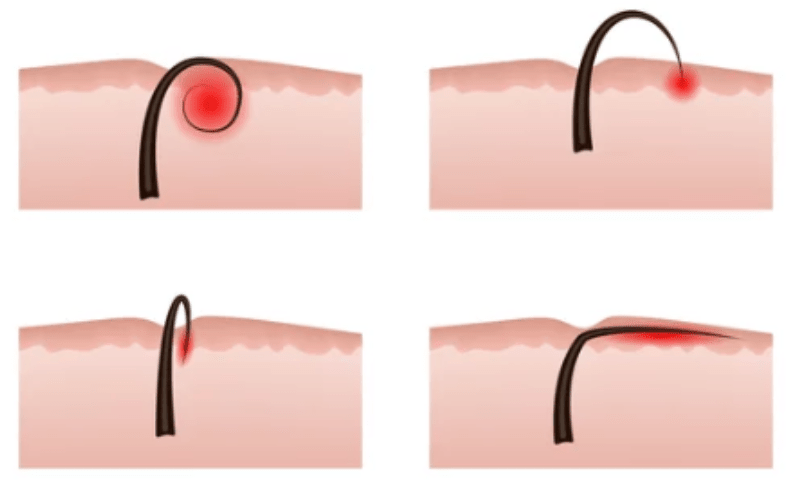Do ingrown hairs kill your vibe?
Learn how to deal with them!
Ingrown hairs are true hassles; they happen to all of us, and no matter where they pop up, they’re always annoying. But there is no need to worry, as I’ve put together a complete guide on how to prevent and treat them once and for all!
But, first thing, first, let me explain what ingrown hair is and what might cause it.
What is an Ingrown Hair?
An ingrown hair is the hair that grows back into the skin after hair removal. As it grows back and dead skin cells collect in the follicle, the hair gets trapped. Thus, it typically takes the form of a red bump (with variable size) and it can become painful and inflamed.
Causes of Ingrown Hair
Genetics play their part as ingrown hairs are more likely to occur in coarse, curly hair. But, ingrown hairs can be caused also by shaving or tweezing the hair, hair breakage, improper waxing techniques, and improper or deficient waxing aftercare (i.e. you don't keep your skin happy by exfoliating and moisturizing it); even wearing very tight clothing can contribute in ingrown hairs.
Prevent & Eliminate Ingrown Hairs
The good news is that if you keep your skin happy and healthy, between your waxes, you won't have to deal with ingrown hair.
Stick to a good post-wax aftercare and mind the following tips:
Wear loose clothes
Breathable material like cotton should be your textile choice, preferably for a few days after waxing. If you wear tight or/and synthetic clothing following your wax it can irritate your freshly waxed skin.
Don't Touch
Of course, you can admire your fabulous hair-free self, but keep your hands off the freshly waxed area. Itching, scratching, picking, and overall touching, might cause irritation to newly smooth and potentially sensitive skin. If you pick ingrown hair, you enter a cycle of inflammation and hyperpigmentation which then becomes frustrating to repair.
No Sweating
Sweating following a wax is a big no-no. Your hair follicles need time to close. That's why you must skip whatever may make you sweat for about 24 hours. Yes, that means gym, sexual activity, saunas, steam rooms, hot showers/tubs, tanning beds, etc.
Exfoliate
Exfoliating regularly, not only helps to remove dead skin cells that clog hair follicles and the area around them, but it can help prevent new ingrown hairs and free existing ones. Keep your exfoliating routine to 3-5 times per week (or as advised by your esthetician). And remember, there is no need to exfoliate so your skin is red and raw. Gentle to mild exfoliation by using an exfoliating body glove or an abrasive body cloth is ideal.
Moisturize
Keep your skin moisturized with a soothing product. This will help keep the surface of the skin supple and soft so the hair can grow back through the surface of the skin easier.
Also, as soft skin means soft hair, your hair won't break when you wax it. Breakage is one of the top causes of ingrown hairs after a wax. So if you have soft hair that’s pulling out from the follicle instead of breaking off at the surface, you’re less likely to get ingrowns right off the bat.
Treat
If you are prone to ingrown hairs and exfoliation and moisturization don't seem to help, you may need to invest in an ingrown treatment serum. Those serums usually contain an ingredient such as salicylic acid, that acts as a chemical exfoliant to further lift dead skin to reveal stubborn ingrown hairs. They also usually contain an ingredient with anti-bacterial properties such as tea tree oil. As there are a lot of such products on the market, your best bet is to stick with the one recommended by your esthetician.
Get a Facial
If after all, your ingrown hair is stubborn and still there, your esthetician might recommend you get a facial that is designed for the problematic area, like the Bits Facial, the Tush Facial, or a professional grade Body Scrub. These services are much like a regular facial, and will leave your skin with fewer ingrown hairs, a brighter complexion, and healthier-looking skin!
Forget the razors
Throw that razor away so you don’t you ever shave in between your wax appointments, as shaving can cause you ingrown hairs.
Waxing at regular intervals will increase your hair-free time between appointments, will reduce the thickness of the hair growth, and will make your waxes much quicker and pain-free!
Laser Hair Removal
If waxing doesn’t help, then laser hair removal is definitely the solution for addressing folliculitis, as it reduces hair growth and follicle irritation. With the right technique and care, laser treatment minimizes the risk of folliculitis, offering long-lasting results and less discomfort.
Questions?
Please read the FAQs or contact me.




